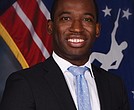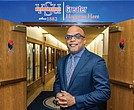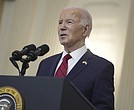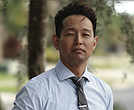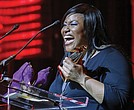New Henrico schools diversity chief ready to push change
By Vanessa Remmers | 10/11/2018, 6 a.m.

Monica Manns keeps certain books within arm’s reach of her desk at the Henrico County Public Schools central office.
She pulls them from her shelf one after another — “Culturally Responsive Teaching & The Brain,” “What If? Short Stories to Spark Diversity Dialogue” and “The Brilliance of Black Boys.”
It’s necessary reading, she said, the kind that will change your life.
The questions the books raise harken to the questions Ms. Manns asked herself years ago, long before she headed up HCPS’s Office of Equity and Diversity.
Back then, part of her work involved student discipline in juvenile justice systems and schools in the Richmond region. Why, she remembers asking herself, were so many of those students African-American?
“Then I started asking questions about the system. I didn’t start out in equity work. But I consider it a calling. Equity work found me,” she said.
At 44, Ms. Manns is heading into her seventh month in the newly created position with Henrico schools, earning about $99,000 a year. She’s the sole person in the office, created last year in the wake of a heinous locker room cellphone video and racist caption posted on Snapchat showing white boys from Short Pump Middle School simulating sex acts on top of their African-American peers. The video made national headlines.
But Ms. Manns is quick to point out what many parents expressed in the weeks following the controversial situation. The video, they said, wasn’t an isolated incident, but part of a years-long pattern of unequal treatment of minority students within Henrico’s increasingly diverse school system.
A similar narrative emerged from parents during listening sessions Ms. Manns held during her first few months on the job.
“The No. 1 issue identified during the Listen and Learn sessions … was the perception of inequities between East End and West End schools,” a newsletter from Ms. Manns’ office states.
The social media video was the tip of the iceberg, Ms. Manns acknowledged.
“You hate to have a tragic event open ears. I think it was a reckoning of recognition,” she said.
Frank Thornton, president of the Henrico Branch NAACP, said HCPS leadership shouldn’t be looking at Ms. Manns as a silver bullet.
“These are some of the systemic issues that have been going on for a long time,” Mr. Thornton said. “There are significant things that need to be done, and she’s a one-person office. She’s in the assessment and data-gathering phase right now. It remains to be seen how much autonomy she has.”
He questioned the level of “power and influence” Ms. Manns will be given and whether she will be given a staff that can help to address such critical problems in the schools.
Ms. Manns said it will take a willingness from local and state officials to move the needle in the right direction. Will the schools embrace her ideas for broadening recruitment efforts to attract more first-generation teachers and teachers of color? Will lawmakers put more money toward such efforts across the state? Will school leadership give her the ability to put new programs into the two newly announced replacement schools in Henrico’s East End? Will the Henrico School Board approve goals for Ms. Mann’s office to be crafted by a new equity committee?
Ms. Manns sees hope in the fact that, so far, she rarely has been told “no.”
She said compared to her previous two stints with HCPS, the division now seems more ready to have such uncomfortable, but necessary conversations to move forward.
From 2004 to 2007, Ms. Manns served as department chair for special education at the Academy at Virginia Randolph, which serves students who want to learn but don’t fit into regular high schools. Its focus is on career and technical education with dropout prevention efforts.
Then from 2013 to 2016, Ms. Manns helped HCPS revamp its student disciplinary policy, including launching a mindfulness program and a voluntary reading group for African-American boys at Fairfield Middle School.
“I don’t want to say that people weren’t listening before, but they weren’t ready,” she said. “They recognize that things need to change.”
This time, Ms. Manns reports directly to Dr. Amy E. Cashwell, Henrico’s new schools superintendent who also is a member of online book clubs Ms. Manns established. Principals and school leaders who are part of the book club can adopt the inclusivity-focused books and pre-crafted lesson plans into their curriculum.
The main question facing Ms. Manns now is where to best focus her energy. It would be easy to spread herself thin, she said.
HCPS enrolls more minority students than white students. The 2017 Henrico school census shows a student population that is 38.8 percent Caucasian, 35.9 percent African-American, 10.9 percent Asian, 9.6 percent Latino and 4.5 percent who identify themselves as belonging to two or more racial groups.
Still, statistics show that African-American students with disabilities and those in special education are disproportionately disciplined in Henrico. Achievement gaps between white and minority students still exist in standardized testing results, county reports and state figures show.
Parents like Felicia Wright remain frustrated.
“I would say the district has failed and continues to fail,” said Ms. Wright, an African-American whose two sons attend Varina High School.
Ms. Wright said she initially wasn’t told about Ms. Manns’ position when she voiced concerns about the school’s treatment of her sons. And she said she hasn’t received a response yet to an email about the situation she sent to Ms. Manns months ago.
“I want the district to be safer overall for students like my son. And I can’t look them in the eye and say that it is — the system is built for the ones that run it.”
On a recent weekday, Ms. Manns headed to the inaugural meeting of the Equity and Diversity Advisory Committee where some of the 26 members like Fonkou Djoendia said they joined to create lasting change.
Mr. Djoendia, who is African-American, said it is important to combat the “big problem” of bullying.
During the meeting, subcommittees picked apart strategic plan goals like “leveraging Henrico’s strength in diversity” and what metrics they would use to track progress toward that goal. Three days later, results of an independent review of Henrico’s special education practices revealed another facet of disparity in the school system.
“For me to be effective, I can’t try to do it all at once,” Ms. Manns said.
She said she plans to use the information gathered from the listening sessions to craft a survey to send to all county households possibly in November. Data from that survey, plus the committee’s decisions on priorities and metrics to measure success, will lead to a plan mapping the new department’s goals and how to get there. The Henrico School Board will have the final say on that plan.
“In my opinion, in a year, she should have identified the problem areas in three major areas, Mr. Thornton said. That includes the culture of central office, how students and their families are treated within various schools and how the school system engages with the community. He said a plan should be developed on how to solve those problems.
He said he’d like to see marked progress in achievement gaps, discipline disparities and disparities in the treatment of special education students by June.
Ms. Manns said she is concentrating on making small, daily changes to address the issues as well as the big picture.
The recent newsletter from her office mentions some of these smaller things — the book clubs, cultural sensitivity training and a “gift box” to principals filled with materials on how school staff can respect and teach about the major religions practiced by students in the county. Schools like Short Pump Middle, which recently underwent cultural sensitivity training, also will be aided by Ms. Manns’ office on creating an action plan to implement the training.
The plan isn’t mandatory, but strongly advised, Ms. Manns said.
The newsletter doesn’t mention another portion of Ms. Manns’ job that she feels is important — talking to people who still believe the narratives that dominated HCPS for years that inequity doesn’t exist.
“I call them my patriots. I hear them out because their perspective is their perspective. But my job is to tell you the counter-narrative to that,” Ms. Manns said.
Ms. Manns sometimes tells people a little about herself. Her mother is Native American, but looked Caucasian, she said. She grew up for a time in Roanoke where she said the public school was largely segregated. Her father is African-American and her stepmother is from El Salvador. Ms. Manns’ children are adopted from Ethiopia.
Sometimes, she simply relies on the numbers.
“The reality is that we are a majority-minority district. And unless you decide to move to the moon, you cannot segregate your students,” she said.

